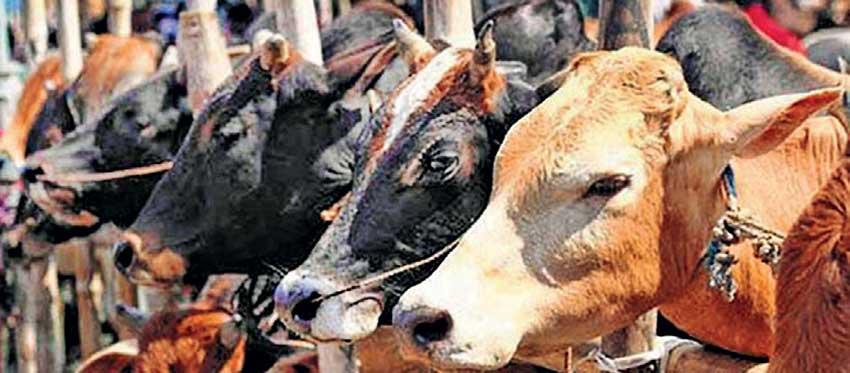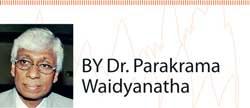29 Oct 2020 - {{hitsCtrl.values.hits}}

 The Prime Minister’s proposal to ban cattle slaughter has been apparently endorsed by the government MPs. Have they considered in depth its consequences on animal and milk production? Moreover, the self-deceptive and ridiculous rule of banning selling of meat but not fish on Poya days only portrays the wisdom of our legislators! Perhaps they believe that fish are mere edible, inanimate, floating objects!
The Prime Minister’s proposal to ban cattle slaughter has been apparently endorsed by the government MPs. Have they considered in depth its consequences on animal and milk production? Moreover, the self-deceptive and ridiculous rule of banning selling of meat but not fish on Poya days only portrays the wisdom of our legislators! Perhaps they believe that fish are mere edible, inanimate, floating objects!
Eating meat necessitates killing until artificial meat production in the test tube becomes a reality. There is research in that direction. Refraining from eating meat as at present means saving millions of animal lives a day!
Globally, there are 1.3 billion cattle, 16 billion chickens, half a billion turkeys and 800 million goats, lining up for the abattoir annually. Let alone the ‘sin’ factor, animal farming and meat eating are huge global food supply, environmental and health issues.
The dilemma is what would the farmer do with culled animals unless they are sold for meat? They constitute a substantial share of his income. If, on the other hand, the unproductive animals are retained on the farm, they will obviously compete with the productive animals for pasture and fodder. This is why the noble mission of Achariya Vinoba Bhave’, the most respected disciple of Mahathma Ghandi, in the late 1940 and 1950s failed. He walked 40,000 miles from village to village across India preaching people not to slaughter cattle, and at the same time asking the rich landlords to part with a few acres of their land for the poor. Both missions were successes initially. However, as the culled animal population increased the farmers were compelled to sell them for meat; and the land donation project too was not a total success as many of the land donees left them fallow! India is now the world’s largest beef exporter!
Meat eating and global grain demand
Apart from pollution and health concerns, beef eating especially, could have serious repercussions on the future global food supply as bulk of the grain goes to produce feed stocks. Globally, over a third of grain –corn, soybean, sunflower, rapeseed, barley and sorghum are cultivated for the sole purpose of livestock feeding. In the U.S an unbelievable 80 percent of all grain produced is for animal feed, states Tibbets in his book” Satisfying the
Global Appetite”
Even some of the poorest African countries are said to divert a share of the grain for animal feed to produce exportable meat. Whereas grain produces between 1.5 to 2.5 food calories for every calorie of fossil fuel burnt, range-fed beef requires 3 calories. By contrast, beef produced from feedlots requires eleven times more calories! This is not all. Meat must be cooked at high temperatures for a long time to be safe for consumption.
Correspondingly, U.S, Cyprus and Ireland consume 273, 288 and 233 pounds per capita per year! Sadly, despite large populations of poor people in the developing world, meat consumption has risen sharply competing for grain. In China it has risen from 8 pounds per capita in 1961 to 119 pounds in 2002, and in Brazil from 61 to 174 pounds. Chinese grain consumption dropped 45 percent in the cities while meat eating rose by 278 percent.
Paradoxically, Ethiopia is the ninth out of ten highest meat eating countries. According to one estimate, the energy used annually to produce meat for one American is equivalent to that consumed by a third world individual in one year! It takes 16 pounds of grain to produce one of beef. Imagine then, for a moment, what impact meat eating will have on food security in the future on a global scale in the light of predicted doubling of the world’s population by 2060. The dire concern is the limitations of land, water and energy resources needed to meet this demand.
Meat eating and environmental pollution
Farmyard manure poses a massive environmental problem; its excessive production in factory farms, in particular, necessitates production of manure ponds or lagoons. In most situations there is more manure than the
soil can accommodate.
Rain and snow storms lead to washing off from manure heaps and these ponds of nitrates, phosphates , heavy metals, other agrochemical residues, bacteria and viruses enter local water supplies. Consequently, in 2001, the Environmental Protection Agency of the U.S forced several hog farms to provide bottled drinking water to those living around farms because seeping manure contaminated the drinking water sources! Livestock account for more than 50 percent of the nitrogen and phosphorus fertilizer in the U.S and many European countries. Millions of U.S people drink from wells with nitrate levels exceeding safe limits, according to an FAO study.
A further FAO study in 2007 has claimed that livestock is the leading contributor to water pollution, globally. Farmyard manure, especially from animals fed with grain and concentrates is known to have toxins, agrochemical residues, in particular heavy metals.
It is often argued that pasture-fed cattle cause minimal environmental pollution, the culprits being the stall-fed animals. That may be true to some degree so long as grazing is of lush pastures where the carbon dioxide emitted by live stock can be effectively sequestered via photosynthesis, as carbon dioxide is a key pollutant as seen later.
On the other hand, by far the greater share of the global pasture cover is overgrazed, and there is little grass for carbon fixation in such pastures during most times of the year. Perhaps both systems of animal farming contribute equally to environmental degradation. The primary cause of deforestation in Latin America is livestock, and Central American rainforests are reported to be degraded at 11 acres per minute in order to grow soybean and corn for cattle.
Meat eating and global warming
Livestock generates more greenhouse gases than transport. The FAO points out that whereas transportation accounts only for 13.5 percent of the global warming via greenhouse gases, livestock contributes 18 percent.
The cattle account for 50 percent of the world’s output of carbon dioxide according to the FAO’s Report: “Livestock’s Long Shadow”. However, a part of this gas is sequestered via photosynthesis in lush pastures, and hence does not escape into the atmosphere. However, in overgrazed pastures this possibly happens only to a minute degree. On the other hand, livestock generates 86 million tons of methane per year, a gas 24 times more potent than carbon dioxide in trapping heat. It is reported that an Argentinean cow belches out up to 1000 litres of gas per day threatening coral reef degradation in the Caribbean! Pigs are bigger culprits as regards manure- produced methane.
The most potent of all greenhouse gases is nitrous oxide, very little of which exists naturally in the atmosphere. It is produced from volatilizing ammonia from nitrogen fertilizer applications, essentially for pasture and feed production, reacting with nitrogen in the atmosphere.
Nitrous oxide is 300 times more potent in trapping heat than carbon dioxide. Unlike carbon dioxide and methane it contributes to ozone depletion. Some 200, 000 tons of this gas is produced annually which persists in the atmosphere for over 100 years!
Meat eating and health
The food-borne bacterial diseases such as E.coli and Salmonella and the frightening prospect of the mad cow disease are serious health concerns. As for cardio-vesicular diseases (CVD), namely coronary heart disease and strokes, it is believed that saturated fats in meat elevate blood serum cholesterol increasing the risk of CVD. Of the three most consumed meats globally, chicken, beef and pork, their saturated fat contents are approximately 37 percent, 52 percent and 44 percent ,implying the risk of CVD is relatively more with eating beef than chicken or pork Of course the overall risk of CVD is determined by a multiplicity of factors apart from the fat composition of the diet.
The WHO recommendation is to confine the total fat content in the diet to less than 30 percent; and the American Heart Association recommends confining the saturated fat intake to 7 percent or less.
There is, however, yet substantial controversy as to the role of dietary fat consumption and the risk of both heart disease and cancer. Many researchers claim that red meat in particular increase the risk of colorectal cancer.
A recent U.S National Institute of Health study with half a million old Americans concluded that people who ate red meat and processed meat over a ten year period were likely to die sooner than those who ate smaller amounts. A similar study with 72,000 women for 18 years confirmed that those who ate red or processed meat had increased risk of heart disease and cancer.
Is fish the answer?
If not meat is fish the answer for dietary protein demand? Fish naturally transforms its feed into edible flesh full of protein and fish oils with health benefits. Fish synthesize more protein with lesser resources than animals do; and one would naturally think that fish is the answer to global protein demand visibly freely available in the oceans and other water bodies with far less environmental pollution. This is furthest
from the truth!
Unlike the farmer the fisherman reaps without sowing and aftercare, and there is the serious threat of overexploitation of fish resources with rapidly increasing demand. The FAO in 2004 reported that 75 percent of the commercial fish stocks are overexploited, and some resources are approaching extension. Taras Grescore in “Bottom Feeder: how to eat ethically in a world of vanishing seafood” (2008) argues that by 2048 the major global fish stocks face total collapse unless urgent remedial action is taken.
Bottom trawling with satellite navigation in vessels with 3000 ton capacity is the technology of the day! “By catch” the fish caught in such trawlers which are fish not consumable and thrown back to the sea amounts to 85-90 percent of the total catch! It is reported that in 1986 and 1987, Norwegian fisherman discarded as ‘bycatch’, 80 million cod fish because they were too small to sell. Little or none survives when they are thrown back into the sea. We end eating only 10 percent of all fish that is killed to feed us. The wasteful ‘slaughter’ here is probably as atrocious as cattle slaughter!
(The writer can be reached via [email protected])
24 Dec 2024 9 hours ago
24 Dec 2024 24 Dec 2024
24 Dec 2024 24 Dec 2024
24 Dec 2024 24 Dec 2024
24 Dec 2024 24 Dec 2024